When I started out in ministry, I had to write three weekly sermons. I quickly learned how to garner biblical information from the text and shape that information into a biblical message that spoke to my audiences. In other words, I learned very quickly how to write expository sermon outlines so that I could delivers sermons to my listeners.
I had learned the fundamentals of how to write expository sermon outlines while studying for my undergraduate degree but it wasn’t until I had to deliver three weekly sermons that I really understood the mechanics behind the process.
In this article, I want to explain the six steps I take to write expository sermon outlines so that I can share God’s word with God’s people. I also share five examples of expository sermon outlines for your perusal!
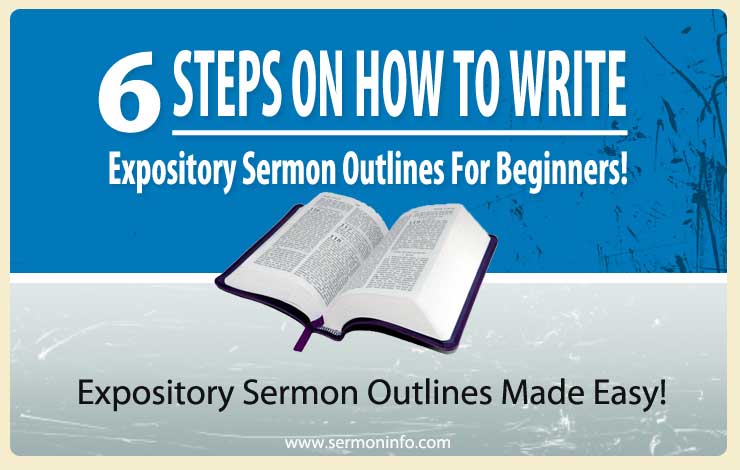
How To Write Expository Sermon Outlines For Beginners
Before we look at the six steps, I want to define expository preaching. To write expository sermon outlines, we need to understand what is expository preaching?
Expository preaching is an effort to explain, illustrate and apply the Scriptures to life.
The word “exposition” is related to the word “expose.” Therefore, expository preaching exposes the meaning of the biblical text verse by verse in order to apply that meaning to a contemporary audience.
As a method, expository preaching is different to topical preaching or textual preaching. Topical and textual preaching begins with a topic and the sermon addresses that topic by going to the Scriptures for support.
Expository preaching draws its topic from a passage of Scripture and develops the supporting material from that passage of Scriptures in order to expand and explain the topic of the sermon. This is the method I will use in this article.
Let me be clear at the outset! The preparation of expository sermon outlines will involve hard work because you will need to spend considerable time studying the Scriptures to garner the biblical information and craft that information into an expository sermon outline.
1. Start With Prayer
I know this is a given but prayer prepares the preacher’s heart for the studying of God’s word (1 Peter 2:1-2) and it prepares the preacher’s mind to receive clarity and insight into God’s word (Psalm 119:18).
2. Study The Scriptures
The expository method requires preachers to study the Scriptures in order to discover the flow of thought in the text of Scripture. Once you have discovered the flow of the text of Scripture, you look for the theme of the text and the supporting material that expands and explains the theme of the text of Scripture.
The best way to do this is to sketch either a diagrammatical outline or a mechanical layout of the text of Scripture. I majored in Greek so I diagram the Greek text to get this information but I also sketch a mechanical layout in English.
Once I do this, I arrange the biblical information on a notebook. This helps me see the big picture of the text of Scripture (see image below).
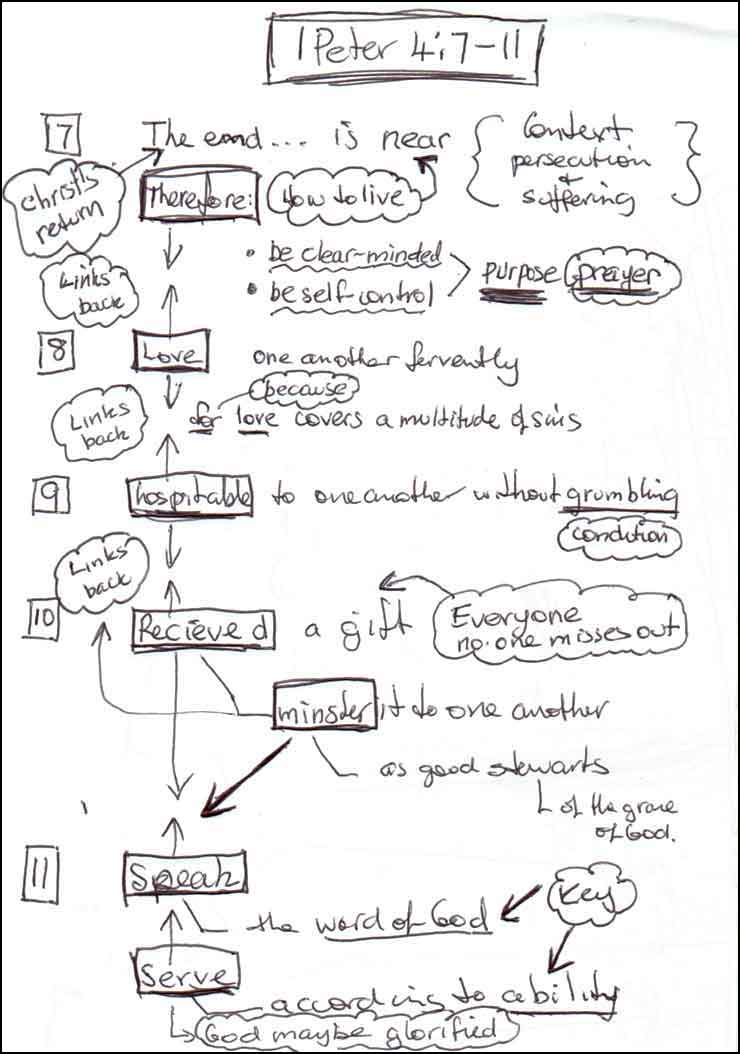
Once I have the mechanical layout of the text of Scripture, I look for the main idea or theme and I look for subordinate ideas and how they relate to main idea and each other.
#1 Example:
Let’s use 1 Peter 4:7-11 as an example of how to manage the biblical information from the mechanical layout of the text of Scripture.
Main Idea or Proposition: The end is near (relating To Christ’s Return).
The Key Word or Transitional Statement: There are four ways to live as we know the end is near.
The Supporting Material:
- Being watchful in prayer (4:7b)
- Loving one another fervently (4:8)
- Being hospitable to one another (4:9)
- Ministering to one another (4:10-11)
The main idea or proposition is the theme of the text of Scripture. The key word or transitional statement allows the preacher to swing all the supporting material into a structure that has cohesion and sequence. The supporting material expands and explains the main idea or proposition. The mechanical layout makes this very obvious.
Note: When I first started with this process, I found I had to spent considerable time studying the text of Scripture and working with the text of Scripture. Once the process became familiar, I noticed that I could do it in my head. In other words, this is a skill that you will develop as you go. I now can write expository sermon outlines very quickly.
#2 Example:
Let’s look at 2 Timothy 3:16-17 as another example of how to manage the biblical information from a mechanical layout of the text of Scripture.
Main Idea or Proposition: The Power of God’s Word.
Key Word or Transitional Statement: There are three reasons for embracing the power of God’s word.
The Supporting Material:
- God’s word is inspired (3:16a)
- God’s word is profitable (3:16b)
- God’s word is dependable (3:17)
The main idea or proposition of this text of Scripture is developed from supporting material. Therefore, the power of God’s word becomes the proposition and the supporting material flows naturally from the main idea.
#3 Example:
Let’s look at Hebrews 12:1-2 as another example of how to manage the biblical information from a mechanical layout of the text of Scripture.
Main Idea or Proposition: Running the Race of Life Faithfully!
Key Word or Transitional Statement: There are four powerful motivations for running the race of life faithfully.
Supporting Material:
- It involves determination (12:1b)
- It involves inspiration (12:1a)
- It involves freedom (12:1c)
- It involves focus (12:2)
The main idea or proposition comes directly from the text of Scripture – run the race of life faithfully. The supporting material is subordinate to the main idea. When you sketch the mechanical layout, this becomes very obvious. Again, you are just allowing the Scriptures to speak for themselves.
#4 Example:
Let’s look at Ephesians 5:1-7 as another example of how to manage the biblical information from the mechanical layout of a text of Scripture.
Main Idea or Proposition: Our New Life in Christ!
Key Word of Transitional Statement: There are five qualities reflected in our new life in Christ.
Supporting Material:
- We walk in godliness (5:1)
- We walk in love (5:2)
- We walk in purity (5:3-4a)
- We walk in thankfulness (5:4b)
- We walk in discernment (5:5-7)
The main idea or proposition comes from the context – our new life in Christ and the supporting material expands and explains the main idea. Again, the mechanical layout makes this very obvious.
#5 Example:
Let’s look at 2 Peter 2:1-3 as another example of how to manage the biblical information from the mechanical layout of a text of Scripture.
Main Idea or Proposition: Be Aware of False Teachers!
Key Word or Transitional Statement: There are three reasons why we need to be aware of false teachers.
Supporting Material:
- False teachers distort the truth (2:1)
- False teachers draw a following (2:2)
- False teachers exploit for personal gain (2:3)
The main idea or proposition comes directly from the text of Scripture and from the larger context of Peter’s letter. The supporting material expands and explains the main idea. Again, the mechanical layout of 2 Peter 2:1-3 makes this very obvious.
If you want to know more about the mechanical layout of Scripture, then I suggest you think about purchasing “Understanding and Applying the Bible by Robertson McQuilkin” (Check it out at Amazon Books) or “Christ-Centered Preaching by Bryan Chapell” (Check it out at Amazon Books).
3. Sketch a Preaching Outline
This is a very important stage in writing expository sermon outlines.
You are now taking the biblical information that resides in the text of Scripture and you are going to sketch an expository sermon outline or preaching outline that resonates in the hearing of the listener.
In other words, you are going to organise the biblical information into a package in order to deliver it to your audience.
The best way to show you how to do this is to give you five examples of expository sermon outlines from the five examples above.
Before I do this, you need to understand that most sermons have three parts – an introduction, a body and a conclusion. The introduction introduces the main preaching point of the sermon. The body of the sermon expands and explains the main preaching point of the sermon and the conclusion sums up the main preaching point with specific application and action.
The body of the sermon has three parts also – the main preaching point, the key word or transitional statement and sub-points. The main preaching point is usually the topic of the sermon. The key word (plural noun) or transitional statement swings all the sub-points from the main preaching point and the sub-points expand and explain the main preaching point. This is clearly demonstrated in the five examples of expository sermon outlines.
#1 Expository Sermon Outline:
Introduction:
There are four WAYS in which we can live in light of Jesus’ return (1 Peter 4:7-11). They are:
1. We need to be watchful in prayer (4:7b)
2. We need to love one another fervently (4:8)
3. We need to show hospitality without grumbling (4:9)
4. We need to minster to one another with our gifts (4:10)
- We may have a speaking gift (4:11a)
- We may have a serving gift (4:11b)
Conclusion:

#2 Expository Sermon Outline:
Introduction:
There are three REASONS why we need to embrace the power of God’s word (2 Timothy 3:16-17). They are:
1.God’s word is inspired (3:16a)
- It pierces the heart (Acts 2:37)
- It reveals the heart (Hebrews 4:12)
2. God’s word is profitable (2 Timothy 3:16b)
- It establishes a right belief (3:16c)
- It establishes a right behaviour (3:16d)
3. God’s word is dependable (3:17)
- It brings you to maturity (3:17a)
- It equips you for ministry (3:17b)
Conclusion:
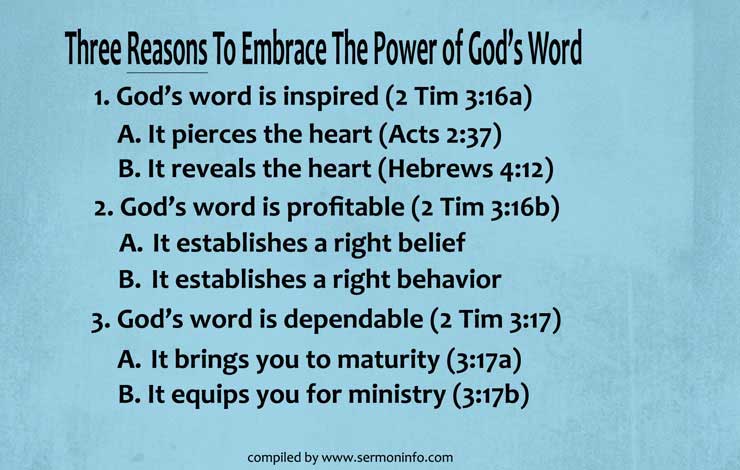
#3 Expository Sermon Outline:
Introduction:
There are four powerful MOTIVATIONS that will help us run the race of life faithfully (Hebrews 12:1-2). They are:
1. We need to be determined (12:1b)
2. We need to be inspired (12:1a)
3. We need to be free (12:1c)
- Free from every weight that holds us back
- Free from every sin that ensnares us
4. We need to be focused (12:2)
Conclusion:
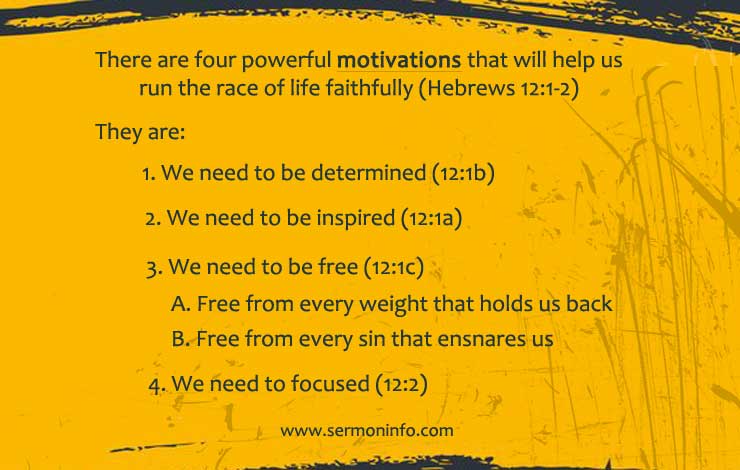
#4 Expository Sermon Outline:
Introduction:
There are five QUALITIES reflected in our new life in Christ (Ephesians 5:1-7). They are:
1. We walk in godliness (51)
2. We walk in love (5:2)
- We seek forgiving love (4:32)
- We seek giving love (5:2b)
- We seek living love (5:2a)
3. We walk in purity (5:3-4a)
- We seek pure behaviour (5:3)
- We seek pure speech (5:4a)
4. We walk in thankfulness (5:4b)
5. We walk in discernment (5:5-7)
- We notice empty promises (5:5)
- We notice empty words (5:6-7)
Conclusion:
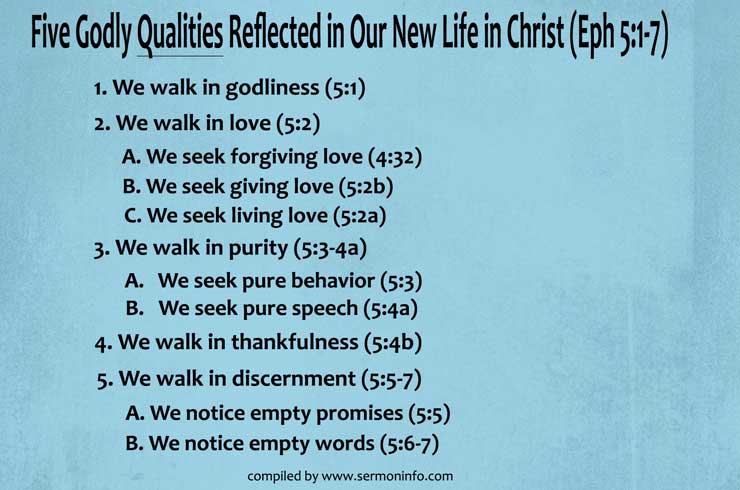
#5 Expository Sermon Outline:
Introduction:
There are three REASONS why we need to be aware of false teachers and workers of evil (2 Peter 2:1-3). They are:
1. They seek to distort the truth (2:1)
- They distort the truth secretly
- They distort the truth through denial
2. The seek to draw a following (2:2)
- They lead you to unholy living
- They lead you to discredit the truth
3. They seek to exploit for personal gain (2:3)
- They seek power, privilege and position
- They peddle cleverly made-up stories
Conclusion:
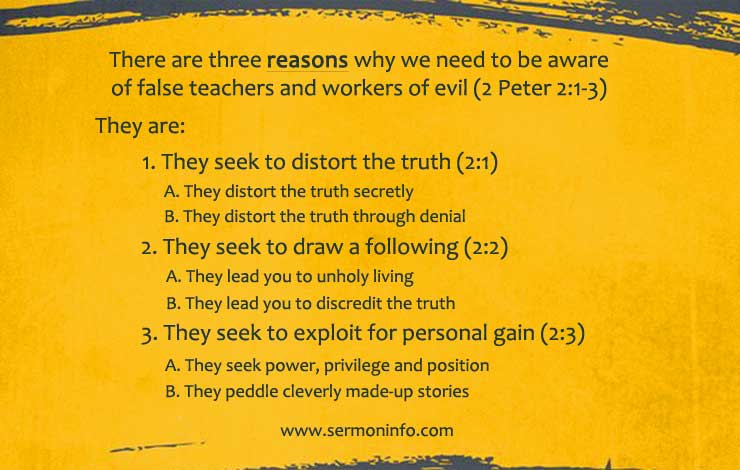
If you want to learn more about sketching expository sermon outlines, then I suggest you think about purchasing “How to Preach Without Notes by Charles Koller” (Check it out at Amazon Books) or “Christ-Centered Preaching by Bryan Chapell” (Check it out at Amazon Books).
4. Select and Write Content Material
I have a discipline whereby I never write a sermon until I have sketched the sermon outline. I tell students not to start writing the sermon manuscript until they are totally satisfied with their sermon outline.
I look at the sermon outline as the skeleton of the sermon. The content material adds flesh to the skeleton. It gives the audience the big picture of the body of the sermon. Therefore, the content material must explain (what does that mean?), prove (Is that true?) and apply (so what?) the biblical truth within the sermon outline.
Let me give you an example of bringing content material to the sermon outline. This is an excerpt from 2 Peter 2:1-2.
The first reason why we need to be aware of false teachers and workers of evil is because they seek to distort the truth. Look at verse 1, “[and these false teachers] will secretly (key phrase) bring in destructive heresies.”
False teachers and workers of evil hide in the shadows and they scheme (the devil is the master schemer). They talk behind your back in secret. They lobby and persuade to get people on side. And the result is they divide, they create divisions and factions.
We may have seen this happen. We may have even seen this happen in the church. I have seen churches split over false teaching.
But God never operates in the shadows because God is light. When God is at work, there is always transparency, openness and honesty. When God is at work, he brings people together. He draws people together.
When false teachers and workers of evil are at work, they divide. They create divisions and factions. They scheme in the shadows and they lobby to get people on side.
God never operates in the shadows. He is not a schemer. He is not a lobbyist. God is truth and we can find that truth in his word.
As God’s servants, we are not called to be schemers or lobbyist. We are called to be his children – open and honest.
As you can see from the excerpt above, the content material explains (what does it mean?), proves (is it true?) and applies (so what?). I also use illustrations to bring different points of the sermon outline to life. It may be a story, example or someone’s testimony. Illustrations are a great way to help your listeners to grasp hold of biblical truth and apply to their lives.
If you want to learn more about how to select and write content material to your sermon outline, then “Biblical Preaching by Haddon Robinson” (Check it out at Amazon Books) would be a good place to start.
5. Scribe an Introduction and Conclusion
Once I finished writing the content material to the sermon outline, I begin the process of writing the introduction and conclusion.
One of the greatest benefits of writing the introduction after putting content material to the sermon outline is that you know exactly what you need to introduce – the subject of the sermon.
The introduction must introduce the main preaching point of the sermon. However, you need to write the introduction keeping mind that you need to get the attention of the audience and you need to touch on why they need to listen to you – uncover their needs.
The conclusion should sum up what the sermon is about with a call to action and prayer. After all, you want the audience to respond to the biblical message by putting the truth into practice. The conclusion should drive the point of the sermon home!
6. Select Good Commentaries
I have spent many years studying the Scriptures (Undergraduate and Postgraduate) but I still need commentaries to help me in the whole process of writing expository sermons.
Commentaries are basically comments about the text of Scripture. They are not inspired but they are helpful with historical content and meaning. They keep me on track and give me ideas that I may not have seen in the study of the text and the mechanical layout of the text.
When I preach through a book of the Bible, I usually purchase about ten one volume commentaries that look at the book from different perspectives like: historical setting and details, cultural aspect to the setting or exegetical in its comments (meaning verse by verse). I also have about ten whole commentaries of the Bible for quick reference material. Sometimes I do not want to read pages and pages to find an answer. Whole Bible commentaries are helpful in those situations.